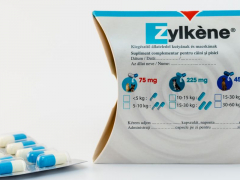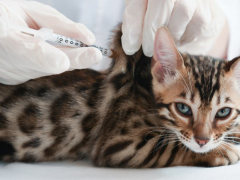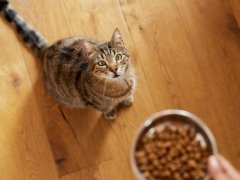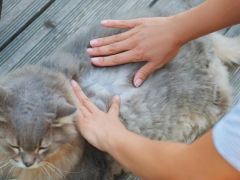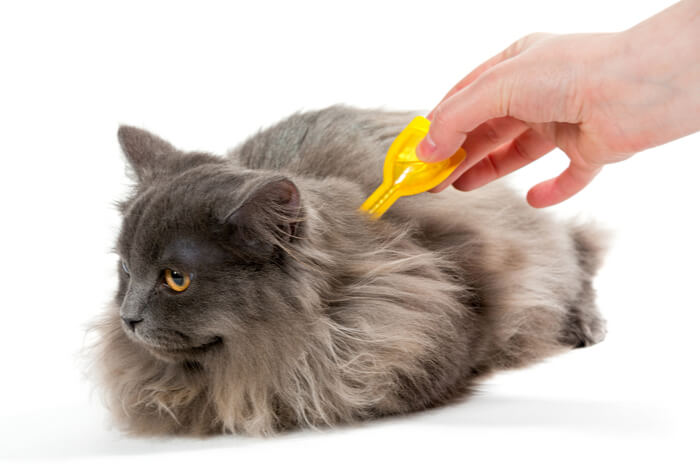
Revolution for cats is a brand of topical, “spot-on” flea, tick, intestinal parasite, and heartworm preventative containing the main ingredient selamectin. Currently, it is available as the two prescription products—Revolution for Cats and Revolution Plus for Cats.
Revolution for Cats Overview

Just want to learn about Revolution Plus? Click here to read our detailed guide.
In this article, you’ll learn about Revolution for cats, the ingredients both Revolution products contain, the types of pests they target, possible side effects to consider, and some frequently asked questions.
About Revolution for Cats

The main ingredient found in Revolution products is selamectin. Selamectin is a topical avermectin antiparasiticide. Selamectin works by enhancing release of a neurotransmitter called GABA. In certain parasitic worms like roundworms and in arthropods like fleas, GABA inhibits nerve conduction. By enhancing GABA release, selamectin essentially causes paralysis and death of the parasites it targets.
Revolution “spot-on” products are applied to the surface of a small target area or “spot” of the skin, usually in front of the shoulders at the back of the neck.
It is important to note that while these pesky pests are affected by Revolution by coming in contact with the skin and don’t have to actually bite a kitty to die, Revolution products for cats do not provide true repellency that would prevent fleas or ticks from coming in contact with a pet.
What Does Revolution Do for Cats?

View On Chewy
The original Revolution provides a spectrum of action against adult fleas and prevents flea eggs from hatching, targets the intestinal worms roundworms and hookworms, ear mites, and mosquito-borne heartworms. While selamectin has some action against the American dog tick, the original Revolution for cats is not indicated for treatment or prevention against ticks.
While not labeled for it, Revolution has also been successful in treating for the sarcoptic mange mite that causes scabies.
The newer Revolution Plus includes the addition of sarolaner, which is an isoxazoline class acaricide/insecticide that inhibits GABA, leading to neuromuscular overstimulation and death of the parasites it targets. The addition of sarolaner broadens Revolution Plus’ spectrum to include 3 ticks, the American dog tick, black-legged/deer tick, and the Gulf Coast tick.
According to the manufacturer, when newly applied, Revolution can start killing fleas within 12 hours with a majority killed within 24 hours. When already applied prior to flea exposure, Revolution can start killing fleas within 6 hours with a majority killed at 12 hours.
The manufacturer states that in lab studies, Revolution Plus started to kill the black-legged/deer tick within 24 hours.
Side Effects of Revolution for Cats
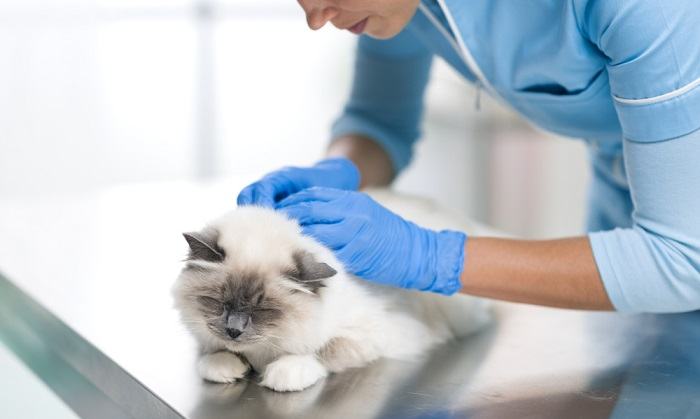
When used properly, side effects to Revolution products for cats are uncommon. Both Revolution and Revolution Plus are labeled for cats 8 weeks of age and older. Revolution Plus is also restricted to cats weighing at least 2.8lb. Topical products like Revolution should never be ingested.
In clinical trials for Revolution, about 1% of cats were found to have a temporary hair loss at the application site, according to the manufacturer. Other signs seen in less than 0.5% of cats included digestive upset, poor appetite, drooling, an abnormally increased breathing rate, and muscle tremors.
In Revolution Plus, a little less than 5% of cats showed signs of looking excessively tired, less than 4% showed signs of skin irritation, and about 3% showed signs of a decreased appetite. No hair loss was documented with Revolution Plus.
At least some of the digestive upset and signs of excessive drooling or salivation may have occurred secondary to kitties licking the product off of themselves after application. Products like Revolution are very bitter tasting, so if a kitty were to lick a recently applied product off either themselves or a housemate, the bitter taste alone can lead to excessive drooling, agitation, and sometimes even vomiting.
According to DVM360’s article “Toxicology Brief: The 10 most common toxicoses in cats” this effect is typically not a true toxicity, but a sometimes dramatic reaction to the bitter taste. Providing milk or liquid from a tuna can help resolve the signs in short order.
To avoid this from happening, it is important to apply any topical flea/tick product to the skin in front of the shoulder blades at the back of the neck, a location even the most flexible cat cannot reach to lick. In multiple cat households where lots of co-grooming occurs, separating housemate kitties for up to 24 hours after application to allow the product to fully dry may be advisable.
Although Revolution products for dogs and cats contain the same active ingredients, the manufacturer does not advise using a dog product on a cat, even if they are similar in weight. Sometimes, there are differences in the inactive ingredients between dog and cat products that would make them inappropriate to consider interchangeable.
And lastly, topical products like Revolution have been known to cause skin and eye irritation in people. It is best to avoid contact with the solution during application and to wash hands after.
Using Caution With Other Flea/Tick Products

In case you have a pup and kitty who like to hang out together or especially groom each other, the best practice is to separate them for 24 hours after applying a topical product to your dog.
While Revolution for Cats has been established as a safe product, the active ingredients may be found in other products in combination with other ingredients that are not safe for cats. This is especially the case with dog products like K9 Advantix II, which contains permethrin, which is extremely toxic to cats.
Fortunately, these products are now required to include a warning against use in cats. But just to be safe, when selecting a flea/tick product for your kitty, always make sure the product includes a picture of a cat and indicates the product is specifically for cats.
It is also always advisable if you have a pup and kitty who like to hang out together or groom each other, to separate them for 24 hours after applying a topical product to your dog, especially if the product contains permethrin.
If you have any concerns for potential toxicity, even if you think your kitty might have just licked some Revolution off her fur and is having a bitter taste reaction, it is always best to contact your veterinarian, or the ASPCA Animal Poison Control Center for further advice.
And lastly, topical products like Revolution have been known to cause skin and eye irritation in people. It is best to avoid contact with the solution during application and to wash your hands after.
Revolution for Cats Dosage
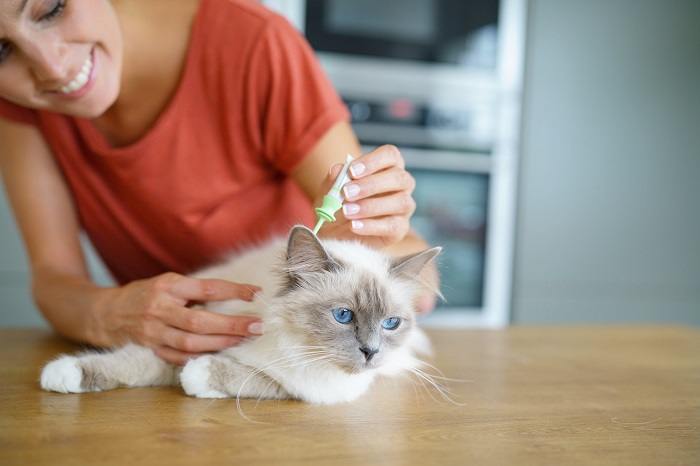
Revolution products are typically applied for monthly dosing every 30 days for the best protection.
Always follow all instructions on the packaging for any topical product you use for your kitty. Revolution vials have a cap that first needs to be pushed down into the vial to puncture it. The cap can then be removed, and the entire contents of the vial applied by parting the fur and applying to the skin along the back of the neck in front of the shoulders where a kitty cannot reach to lick it off of himself.
While Revolution products are considered to be waterproof within 2 hours of application, the manufacturer still recommends waiting 24 hours to bathe your kitty after application. Bathing shortly before application may also reduce its effectiveness.
If for some reason you are unsure if the product was administered correctly or whether all of it was applied, it is usually safest to not apply an additional dose.
If you have any questions about application or safety for Revolution products or any topical product, make sure to get in touch with your veterinarian.
Conclusion

Revolution has been used for cats for many years and is generally a safe and effective product when used properly. Because it is a heartworm preventative, it is important to remember that both Revolution products require a prescription.
Drug Dosing Disclaimer: We are only able to provide doses for medications that are FDA approved for use in cats and only as the label guidelines dictate. For medications that are used off-label we can only provide guidelines and safety information for use. Safe and appropriate dosing for off-label medications can only be determined by a primary care veterinarian.
We encourage you to work with your veterinarian to determine if a particular medication is appropriate for your cat. Changing or adjusting a dose for your cat on your own without consulting with a veterinarian can carry risk. We do not encourage use of medications prescribed for human use in pets without first consulting with a primary care veterinarian.
Frequently Asked Questions
What Does Revolution for Cats Treat?
The original Revolution for cats kills adult fleas and prevents flea eggs from hatching for one month, preventing and controlling flea infestations with continued use. It can also treat and control intestinal roundworm and hookworm infections, as well as ear mite infestations. It is labeled for prevention of mosquito-borne heartworm disease, but cannot be used to treat active heartworm disease.
Revolution Plus for cats has the same spectrum of coverage above, but the addition of sarolaner provides for the treatment and control of tick infestations caused by the black-legged/deer tick, Gulf Coast tick, and American dog tick.
Do I Need a Prescription for Revolution for Cats?
Yes, indeed you do. All heartworm preventatives for pets require a prescription. Even if ordered online, a prescription request will still need to be sent to your veterinarian for approval. The main reason for this is that some pets can be at a higher risk of a reaction for some products if the product is given or applied while the pet has an active heartworm infection.
While cats are not as routinely tested for heartworm as dogs are, owing to the fact that only about 50% of cats truly infected with heartworm will show up positive for the disease on a test, it’s still important for a veterinarian to verify that a kitty is not showing signs of illness prior to starting.
How Effective is Revolution for Cats?
Revolution has slower kill times for fleas and ticks compared to other topical products like Frontline Plus and Advantage II. However, the ingredients in Revolution Plus make it one of the best all-around products for cats with the best broad spectrum of coverage targeting fleas, ticks, heartworm, and intestinal parasites.
The question of flea resistance to products like Revolution and the idea that they don’t work comes up often. The 2017 article “Perception vs. Reality: Insecticide Resistance in Fleas” from DVM360 that refers to an article published in American Veterinarian that same year addresses this topic.
An entomology (“bug science”) professor from the University of California heavily investigated this question and concluded that while resistance has been seen to some flea treatment or prevention products, true chemical resistance in fleas with fipronil, imidacloprid, and some other newer products on the market has not yet been demonstrated.
In many cases, when a pup or kitty parent is still seeing live fleas on their pet after a product has been applied, this issue can most often be traced back to incorrect use or application of the product, as well as poor expectations. Following are some common errors or misperceptions.
- Incorrect application. (i.e. applied to the fur not the skin, failing to apply the whole volume of product, failure to properly puncture or open a vial prior to application).
- Failure to apply to all pets in the household. If one pet brings fleas indoors, they can jump onto all pets in the home. If all pets are not treated at the same time, flea infestations can persist.
- Bathing. Baths are a common go-to, especially when live fleas are seen. However, while waterproof, Revolution products need 24 hours to spread throughout the oils on the skin. Bathing shortly before or after application removes oils from the skin as well as possibly the product itself.
- Not Treating Long-Enough. It can sometimes take as long as 3 months to clear out a flea infestation. So while most veterinarians advise year-round protection against fleas and ticks, a product like Revolution should be used every month for at least 3 months during an active infestation. Flea eggs not cleared from the home environment are likely to continue hatching every couple of weeks, meaning a kitty that received only one monthly dose of Revolution can get infested again a few weeks later if the dose is not repeated the next month.
- Not Treating Year-Round. Fleas have been known to over-winter indoors. Treating pets for only certain months of the year can leave open gaps in prevention for infestations to occur.
- Failing to Treat the Environment. Because one flea can lay up to 50 eggs in just one day, the amount of eggs in a home environment with fleas can be staggering. If the environment is not treated effectively, continually hatching fleas may continue to be found on a treated pet.
- Perceiving Products as Repellents. Always remember that most topical products like Revolution do not have repellency action, meaning that fleas and ticks must come in contact with the skin to be killed. Heavily-infested outdoor areas as well as poorly-treated indoor infestations can be sources for large numbers of adult fleas to “suddenly” appear on a treated pet.
If You Still Feel There’s a True Product Issue
If you feel you have applied a product properly and are addressing a flea infestation according to your vet’s instructions and still feel that a product is not working well, make sure to bring those concerns to your vet or contact the manufacturer of the product.
Is Revolution the Best Flea Treatment for Cats?
When compared to Revolution, Advantage and Frontline products have faster kill times for fleas. Advantage II and Frontline GOLD also more effectively treat the entire flea life cycle including not just eggs but larvae as well. For getting rid of an active flea infestation in your home, Frontline Plus, Frontline GOLD, or Advantage II are probably better choices.
However, Revolution does have advantages to consider. When choosing a product, always make sure to think about all risks present to your kitty. With a spectrum that includes not just fleas but heartworms, ticks, sarcoptic mite mange, ear mites, and a couple intestinal parasites, it’s fairly unmatched in terms of having a pretty broad spectrum of coverage.
Most pets are at risk from all of these critters, but there can be regional variation. If you’re not sure what risks are more prevalent in your region, make sure to ask your veterinarian.
